Patan, also known as "A City of Fine Arts," is a destination in the Kathmandu valley that absolutely cannot be missed. Patan is also known as Lalitpur, and it is situated five kilometers to south of the capital city of Kathmandu. Patan is the oldest city in Nepal and serves as the district capital of Lalitpur. The breathtaking sculpture and architecture that can be found in Patan Durbar Square dates back to the 16th century and even further.
History of Patan Durbar Square
If we look at the history of Patan, we find that, according to sources that are accepted in the scientific community, Patan's history dates back to the Licchhavi period. This is demonstrated by an inscription that was placed on the Manga Hiti (Water Spouts), which was built by Bharbi (grandson of Mandev) on the date 570 AD. It is also said that Emperor Ashoka, who made a significant contribution to the expansion and development of Buddhism between the years 304 and 233 B.C., was responsible for the construction of the four stupas that can be found outside of the corner of the palace.
Patan Durbar Square Location?
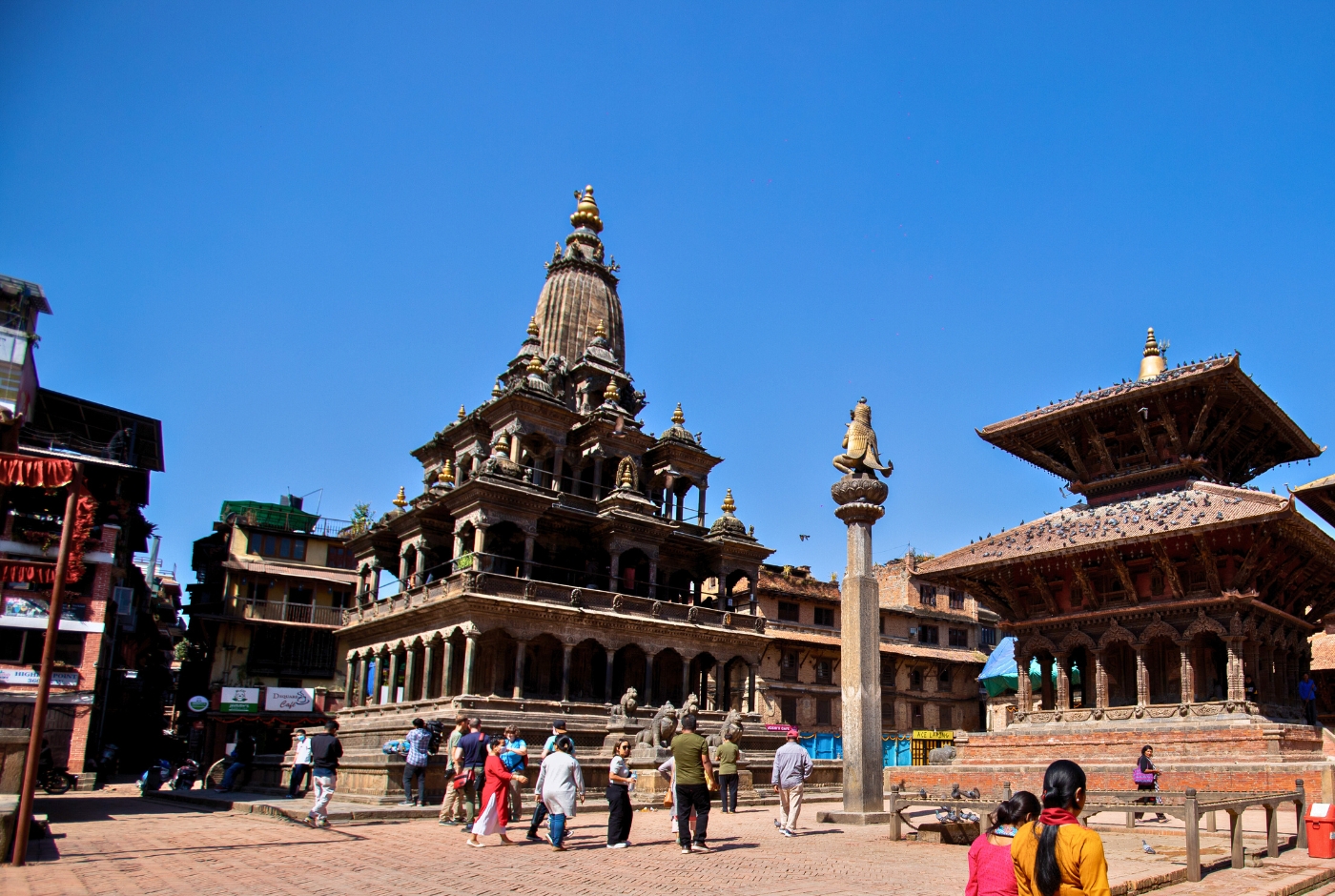
Nevertheless, the majority of the palace's monuments were built during the reign of King Siddhi Narsingh Malla (1618–1661 AD), who was Patan's first independent Malla dynasty king. This king oversaw the construction of the palace complex. As a consequence of this, numerous Malla royal families ruled, worshipped, and resided in the area now known as Lalitpur. As a consequence of this, Patan Durbar Square is surrounded on all four sides by historically significant temples and monuments. In the surrounding area, we can make out a variety of architectural styles represented in the buildings. Around the square, there are numerous examples of different architectural styles that have been reflected in the buildings.
After that, in the year 1768 AD, the late King Prithivi Narayan Shah the Great of Gorkha successfully took control of the city of Patan without resorting to violence. The journey from Kathmandu to Patan felt more like traveling through a town than the actual journey itself due to Patan's unique character. But when you step into Patan Durbar Square, you are busy to a totally different place.
The Complex of Patan Durbar Square's Primary Tourist Attraction
Ancient temples and monuments with rich and well-known historical sites are the primary attractions to the tourist industry. Still, here is a list of ancient temples and monuments that are some of the most popular places for tourists to visit in the area:
Hiryanya Varna Mahabihar (Golden Temple): This Buddha shrine is only three to four minutes' walking distance from the complex that is commonly known as the Golden Temple of Buddha in Patan, Nepal. This temple is also known as the Hiryanya Varna Mahabihar. It is without a doubt the oldest structure, the richest one, and the most well-known one. It is said that King Bhaskar Verma constructed the temple sometime in the 12th century. It is a golden pagoda-style temple with three stories that is dedicated to Shakyamuni Buddha, who was born in the forest of Lumbini. In the interior of the temple, on the upper level of the storied pagoda, there are exclusive depictions of Amoghpash Lokeshwor, as well as a sizable prayer wheel. Its walls are adorned with paintings and carvings that depict Buddha's extensive and functional life history. Some of these carvings are quite beautiful.
Each and Every Mahavihar Tradition's Information
A Buddhist monastery is also sometimes referred to as a vihara. Viharas has been connected ever since the life of the Buddha. Shakyamuni Buddha is revered as the supreme deity in each and every vihara. In addition to this, there are statues of the Panchadyani Buddha, Tara, Lokeshwor, and various bodhisattvas that are kept. During the 12th to the 18th centuries, Buddhism was on the decline in India but flourishing in Nepal, particularly in Patan. Patan is home to more than 300 different types of vihara.
The primary temple in Vehar is designed in the Nepali pagoda style. In Bihar, the door is always positioned on the east side of the building, and in front of the gate is a pair of lion statues—one male and one female—that serve as guards as a representation of the power of the protective deity. The first Bihar of Nepal, Kundari, can be found in Lumbini, which is located in the southwestern region of Nepal. The combination of metal and wood in Viharas' architecture makes for an attractive aesthetic. Bricks, wood, mud, metal, and stone are some of the materials that have been used to make Bihar.
The Kumbeshwor Mahadev Temple: It will take you between five and seven minutes to walk there from the main complex of the Durbar Square. It is one of the two temples in the Kathmandu valley that has five stories; the other one is the Nyatapole temple in Bhaktapur. In point of fact, the worship of Lord Shiva is the focus of this Kumbeshwor Mahadeva temple (a destroyer God).
After Pashupatinath temple, this is the second most frequented place of worship in all of Nepal. It is widely held that Lord Shiva spends six months of each year during the winter in the Kumbeshwor temple. After that, it is believed that he travels to the summit of Gaurishanker, which is located 43 kilometers north of Kathmandu, to spend the summer with his spouse, Parvati. This pagoda-style temple dedicated to Lord Shiva was constructed in the 14th century (around 1392 AD) during the reign of King Jayasthiti Malla, making it Patan's oldest temple. It has five roofs and is designed in the style of a pagoda. A religious fair is held in Kumbeshwor during the time of the sacred thread festival, also known as Janae Purnima or Raksha Bandhan. This festival begins on the day that the full moon occurs in August.
Patan Durbar Square: Temple Photos
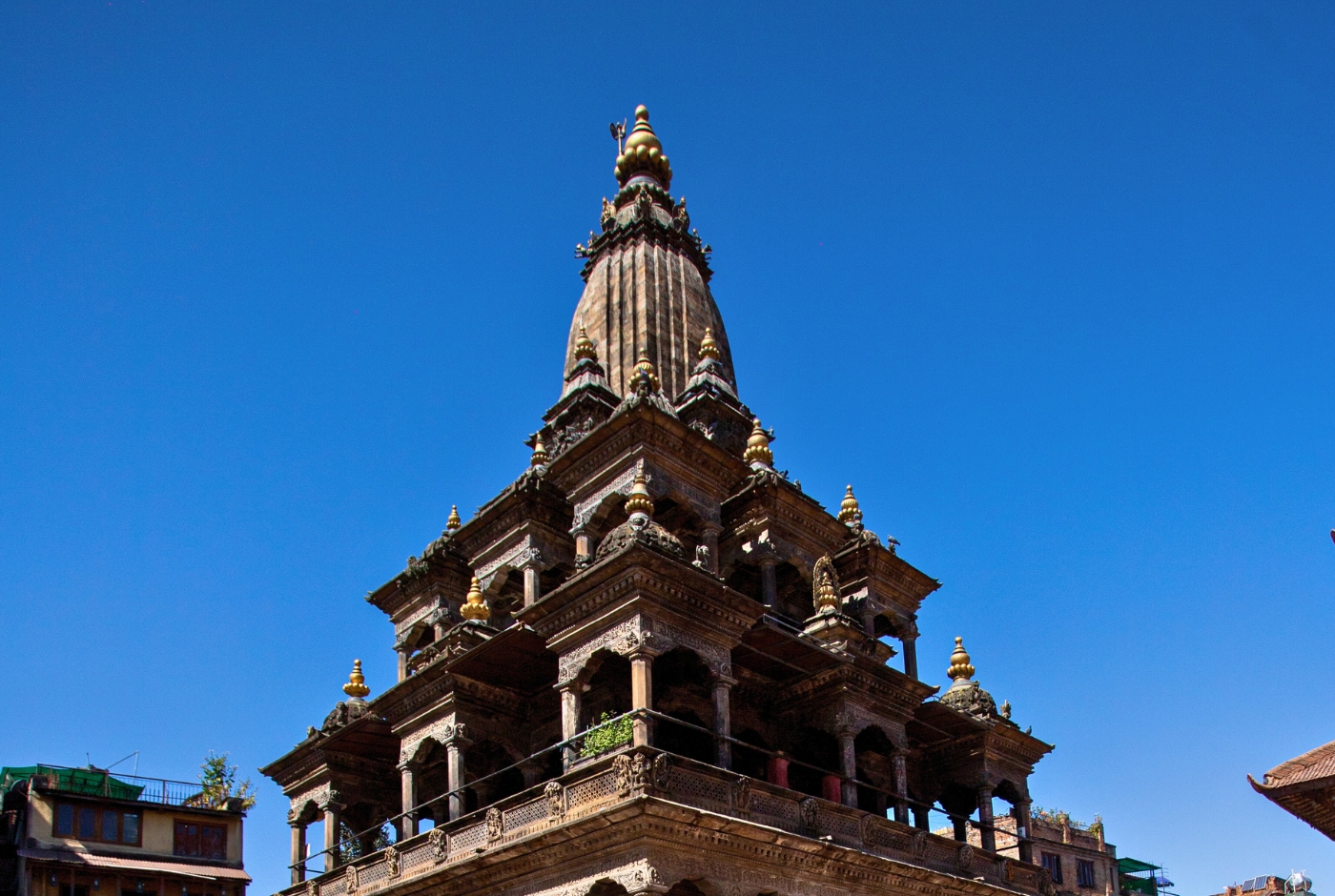
The History and Characteristics of All Hindu Temples
A temple is another name for the House of God. If I were to tell you about the architecture of temples, I would tell you that there are many different styles of temples, such as the Shikhara style, the Dome style, and the Mix style. The style of the temple with multiple roofs is known as the Nepali style of temple. which is also referred to as the Newar style, the Mandapa style, and the Pagoda style. The Licchhavi period is when temples in the Nepali style first appeared. Modern design, on the other hand, is inspired by contemporary architecture.
- A temple designed in the Nepali style will typically have a square or rectangular floor plan, and it will also be built on multiple plinths.
- In order to get to the temple, you have to climb a steep hill.
- Four-Door (According to legend, four faces must worship from four directions).
- A revolving or circular path to take.
- The upper portion of the temple door or gate, also known as the tympanum or torans (Shiva Murti or Vishnu Murti),
- The sanctum always on the ground floor.
- Supported by wooden struts that are oriented at a 45-degree angle to one another.
- At the upper part of the story, there is a window that does not function and a floor that does not function.
- Wind chimes serve primarily an aesthetic purpose.
- The Metal Pinnacle at the very top (represents the Five Gods: Surya, Ganesh, Devi, Vishnu, and Middle Shiva)
- Brick, stone, wood, lime mortar, and Surki are the materials that are used to build the temple.
Krishna Mandir:
The Krishna temple, which is located on the western side of Patan's Durbar square, was constructed in the year 1636. It is said in the legend that it was constructed because of a dream. King Siddhi Narsingh Malla had a dream once that the gods Krishna and Radha were in front of the palace. In the dream, they were holding hands. The King gave the order to construct a temple in the same location.
A decade later, when the kingdom was engaged in conflict with one of its neighbors, the king eventually conquered after praying to Krishna for help in defeating his foes. In an expression of his appreciation, the King constructed an exact copy of the temple within the Sundari Chowk courtyard. The Shikhara architectural style was brought all the way from India to be used in the construction of the Krishna temple. Three levels can be found beneath the structure's 21 golden peaks. On the ground level is an altar dedicated to Krishna, on the second floor to Shiva, and on the third floor to Lokeshwor. The Krishna Mandir in Nepal is the country's first building to be designed in the Shikhara style.
Facts, History, and Characteristics of the Shikhara Style of Architecture Found in Nepalese Temples
A mountain peak inspired the design of this temple, built in the shikhara style. The Shikhara style is also known as the Nagara style, the Beasara style, the Dravida style, the Ratha style, and the Northern style. South Indian temples are designed in the Besara and Dravida traditions. The Nagara style is well-known throughout Nepal, particularly in Kathmandu and the western regions of the country. Both the Krishna temple and the Mahabouddha temple in Patan are significant examples of the Shikhara architectural style. The places of worship include the Siddi Laxmi Temple and the Narayan Temple, both located in Bhaktapur; the Shiva Mandir located in Kathmandu; Anantapur; and Pratappur, which is the location of the Monkey Temple.
The oldest temple built in the Shikhara architectural style is located in Nepal's western region. This temple, Binayak Panchadeval, dates back to the 13th century. The Shikhara-style temple can be traced back to India as far as the Vedic period (3500 years ago). In Nepal, a temple from the Licchhavi period that was built in the shikhara style was destroyed. In point of fact, they came all the way from India.
- The Shikhara style is characterized by its use of a square floor plan. A built-in Multiplinth can be found in Kathmandu.
- Temple have Circular path
- Being without a roof.
- There is only one door.
- False door/window (appearance but inability to open)
- Sanctum is located on the first floor.
- Carvings on the exterior wall
- Pinnacles in Kathmandu are typically made of metal.
- Materials: stone and brick
- a minimal amount of use of wooden components.
- In the Shikhara style, there are three different kinds of joints: an internal lock system, a lock system using a pin, and lime/surki/mortar.
The dome style is a fusion of the Nepali and Shikhara architectural traditions. It is due to influence from the Mughals. (The Mosque of the Muslims and the Taj Mahal of India).
Yognarendra Malla, another king, built the temple of Manimandap between the years 1684 and 1705 AD, and he carved his own statue into the capital stone pillar of the temple.
Mul Chowk, Sundari Chowk, and Keshav Narayan Chowk are the three primary chowks (courtyards) that makeup Patan Durbar Square. This is another of the square's attractions.
Mul Chowk: The Mul Chowk is the largest of the three main courtyards found within the palace, and it is guarded by two lions at its entrance. Srinivasa Malla was king from 1661 to 1684 AD. His father, Siddhi Narsingh Malla, had started building Mul Chowk, and Srinivasa Malla finished it. He also made the temples of Taleju and Bhimsen temple while he was king.
Sundari Chowk: The Royal Bath, also known as Tushahity (Sunken water tank), was built by Siddhi Narsingh Malla in the year 1647 AD and is located in the center of Sundari Chowk, which is located to the south of Mul Chowk. On it are carved in stone the tantric Hindu deities Narayan and Lakshmi, numbering a total of seventy-two. You will notice a massive stone platform in front of Tusha Hiti when you get there. In addition, there are 550 engraved wooden Shiva Lingas located all around the palace in Sundari Chowk. King Siddhi Narsingh Malla also built the temple of Taleju and the Bhandarkhal pond.
Keshav Narayan Chowk: The Keshav Narayan Chowk, which is located in the Palace Complex's northernmost courtyard, is not only the most important but also one of the oldest courtyards. The Patan Museum is located in the grounds of the earliest Malla palace in Lalitpur, which now serves as the museum. A temple dedicated to Keshav Narayan, a form of Lord Vishnu with four arms, can be found standing in the middle of the inner courtyard. In historical accounts, this area is called Chaukot Durbar, which literally means "four-cornered-fort-palace."
Mahabouddha Temple: The Maha Bouddha Temple is a Buddhist temple designed in the Shikhar style. It is also known as the "Temple of a Thousand Buddhas." Bricks of terracotta are used to construct it, and it features intricate statues and carvings. A priest from Patan named Abhaya Raj Shakya traveled to the well-known Mahabodhi temple in Bodhgaya, which is located in India, around the year 1500 AD. While he was in Bodhgaya, he attended classes on how to make coins. After returning to Kathmandu, he applied for and was granted permission to launch a royal pristine in his personal courtyard. The construction of this Maha Bouddha temple was started by him in 1564, but he only lived to see the foundation finished before he passed away. After that, each of Abhaya's five sons contributed to the completion of the temple in their own way. The construction of the Mahabouddha temple was completed in the year 1600. This temple was not finished until 1564 AD, later the efforts of three generations spanned over a period of 36 years (1564 AD to 1600 AD) to complete this temple. An earthquake that occurred in 1934 caused significant damage to the temple, and an extensive restoration project was necessary to facilitate the majority of the necessary repairs. And then again in 1999 AD, as part of maintenance performed by the organization responsible for maintaining the Mahabouddha temple.
The Rato (red) Machhendranath and Minnath Temples: The Rato (red) Machhendranath temple is located in Tabahal, which is located south of Durbar Square on the western side of the road. It is said that Rato Machhendranath, the god of rain, has existed in many different forms throughout history. To Buddhists, he is Avalokiteshwor in his tantric guise, while to Hindus, he is a manifestation of Shiva in one of his many guises.
The current structure of Rato Machhendranath Temple, which has three stories and is located in a spacious courtyard, dates back to the year 1673 AD. On the other hand, the earlier temple may have been present at the site as early as 1408. The entrances to the temple are carved in the form of lions, and there are four of them. Rato Machhendranath, also known as Avalokiteshwor, is stored in this location for six months before being moved to Bungmati for another six months of storage. There is a temple dedicated to the Buddhist Bodhisattva that is located close to the Rato Machhendranath Temple.
This Bodhisattva is often thought of as Rato Machhendranath’s younger brother. The temple was originally built between the third and ninth centuries AD, but it has been renovated on multiple occasions. The primary characteristics of the Minnath temple are the sculpted figures of the goddess with many arms that are located on the roof struts. The festival will begin in the final week of May or at the beginning of June. It is celebrated as the god of the harvest. (a chariot that is 48 feet tall).
Patan Durbar, Kathmandu
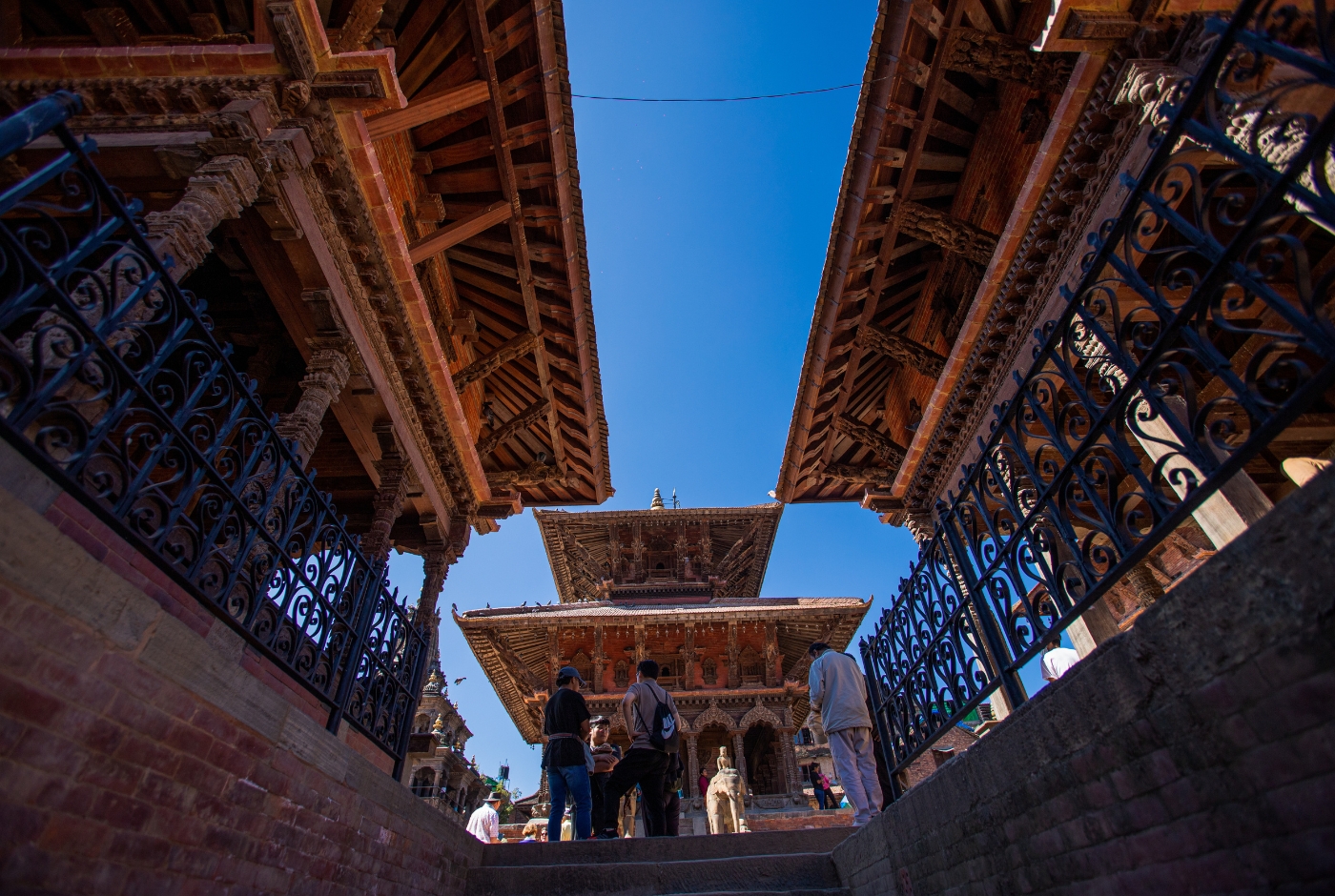
Where is Patan? Where is Patan Durbar Square located in Nepal?
Patan, also known as Lalitpur, is located in the Kathmandu Valley in Nepal. It is a neighboring city situated just south/southeast of the core Kathmandu city center, serving as a central and historically significant area. Essentially, it's part of the broader Kathmandu metropolitan area. It's one of the three historic royal cities of the Kathmandu Valley (along with Kathmandu and Bhaktapur) and is famous for its ancient architecture, especially its Durbar Square.
Patan Bus Park
Patan Bus Park, also known as Lalitpur Bus Park, is a central transportation hub in Patan (Lalitpur), Nepal. It's a major stop for public buses connecting Patan to other areas in the Kathmandu Valley and surrounding districts. The park is located in Lagankhel, which is a central area within Lalitpur.
How can I reach Patan Durbar Square from Kathmandu?
Doesn’t matter where you are in the Kathmandu Valley; a taxi is the best option to select. You can ask to be taken to Patan Durbar Square or Lagankhel, and they will do so. Just be cautious about trading before accepting the trip.
From Thamel: If you are seeking a comfortable and convenient mode of transportation to Patan Lalitpur, taxis can be hired in Thamel. If you are traveling on a Budget, get to the bus terminal at Ratan Park (Purano Bus Park) and take one of the buses to Lagankhel. Nowadays, you can directly get a drive from Ratna Park to Lalitpur Patan Durbar Square. Patan Durbar Square may be reached on foot from the bus stand in Lagankhel.
Where is Patan Located from Kathmandu?
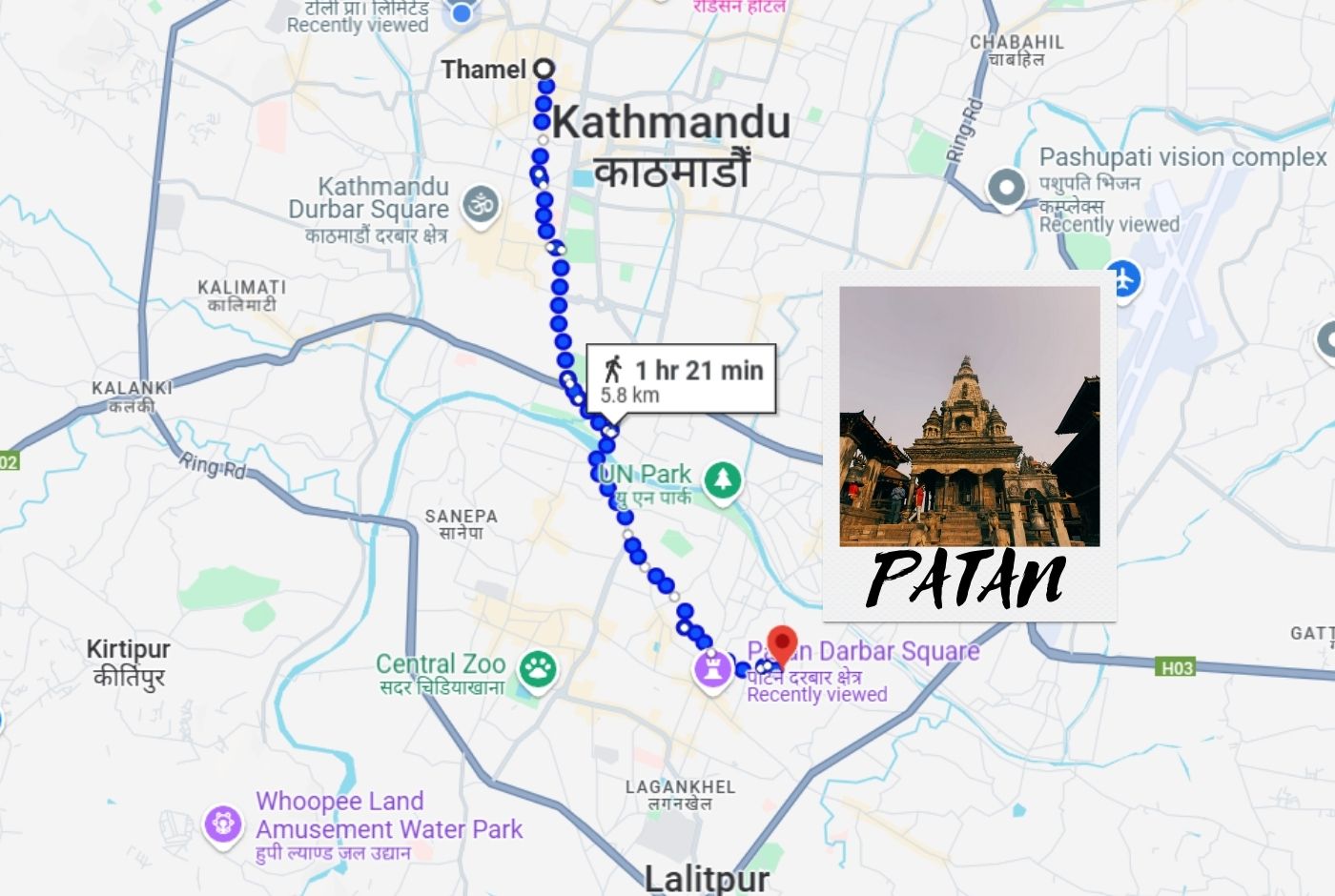
Solo Traveler Tip: If you're traveling alone, we recommend using Pathao for a convenient, fast, and easy ride to Patan Durbar Square. Simply download the Pathao app from Google Play, book a motorbike or car ride, and reach your destination. If you're in the Lalitpur area, you can easily navigate to Patan Durbar Square using Google Maps. Simply search for "Patan Durbar Square" on Google Maps, and it will provide you with the correct directions from your current destination to the Durbar Square.
Patan Weather
Patan weather patterns are typical of this temperate region. The valley experiences four distinct seasons: Spring, Summer (Monsoon), Autumn, and Winter. The climate is generally pleasant, though conditions can vary significantly throughout the year, primarily influenced by altitude and the monsoon system.
Patan in Spring (March to May)
Spring in Patan is a transitional period characterized by gradually warming temperatures and increasing daylight hours. This season 2025 patan sees average high temperatures rising from around 23°C (73°F) in March to potentially reaching 29°C (84°F) or 30°C (86°F) by May. Nighttime lows become milder, typically ranging from 10°C (50°F) to 17°C (63°F). The weather is often pleasant with clear skies early in the season, making it a good time for sightseeing. As spring progresses, particularly in April and May, there's an increasing chance of pre-monsoon thunderstorms in the late afternoon or evening, and humidity begins to rise.
Patan Area During Summer / Monsoon (June to September)
The summer months coincide with the monsoon season, bringing the majority of Nepal's annual rainfall to the Kathmandu Valley, including Patan. This period is characterized by high humidity and warmth. Average high temperatures are typically in the range of 25°C (77°F) to 28°C (82°F), but the high humidity can make it feel considerably warmer. Nights are warm, with lows generally staying above 19°C (66°F), often around 20°C or more. Heavy rain showers are common, particularly in July and August, though it doesn't usually rain constantly all day. The rain can impact travel and visibility of distant mountains.
Patan in Autumn (October to November)
Autumn is widely considered the best time to visit Patan and the Kathmandu Valley. Following the monsoon, the air is cleansed, offering incredibly clear skies and spectacular panoramic views of the Himalayan peaks. Temperatures are very pleasant, with average highs in October around 25°C (77°F) and dropping to a comfortable 20°C (68°F) by November. Nights become cooler as the season progresses, with average lows falling from around 10°C (50°F) in October to closer to single digits or 10°C (50°F) in November. This dry and stable weather makes it ideal for outdoor activities and exploring the city's heritage sites.
Winter (December to February)
Winter in Patan is the coldest time of year, particularly in the mornings and evenings. While daytime temperatures can be pleasant, often ranging from average highs of 17°C (63°F) to 19°C (66°F), nighttime lows can drop significantly, averaging between 2°C and 7°C (36°F to 45°F) and sometimes falling near or even slightly below freezing. Winter days often feature clear skies, especially mid-day, offering good sunshine. However, morning fog or haze can sometimes be present, and the air is generally dry. Rainfall is minimal during this season.
Patan Museum
The Patan Museum showcases a stunning collection of traditional sacred arts of Nepal. While it possesses over 1,100 artifacts, around 200 are on permanent display across themed galleries. The majority of these are exquisite cast bronzes and gilt copper repoussé work, crafts for which Patan is renowned. These masterpieces primarily depict Hindu and Buddhist deities, with many originating from workshops in the Kathmandu Valley and Patan itself. The exhibits cover a vast span of Nepal's cultural history, including rare objects from the Malla era, such as the Malla throne. Visitors can explore sculptures of prominent deities like Vishnu, Shiva, and Ganesh, as well as various representations of Bodhisattvas. The museum also features artifacts from India, Tibet, and the western Himalayan regions. Detailed captions, some authored by scholar Mary Slusser, explain the artistic, spiritual, and historical significance of the objects, connecting them to the living traditions of Hinduism and Buddhism.
The museum's setting within the architecturally magnificent Patan Durbar Square further enhances the visitor experience, offering an open-air exploration that extends to multiple courtyards, including the Mul Chowk, Sundari Chowk with its exquisite Tusha Hiti step well, and the Bhandarkhal Tank. Whether you are an art enthusiast, a history buff, or a curious traveler, the Patan Museum promises an enriching and memorable experience.
Ticket price for the Patan | Patan Durbar Square Entry Fees (Including Patan Museum)
The entry fee for Patan Durbar Square, which includes access to the Patan Museum, varies by nationality and visitor type.
- Foreign nationals are required to pay NPR 1,000, while SAARC nationals (Indian nations), including BIMSTEC members, are charged NPR 250.
- Chinese nationals fall under the foreign national category and also pay NPR 1,000.
- Nepalese citizens can enter the square free of charge; however, access to the museum requires a separate ticket priced at NPR 30.
- Nepalese students benefit from significant discounts—those with an official letter from their school pay only NPR 10, while those presenting a valid student ID pay NPR 15.
These fees help support the preservation and maintenance of this UNESCO World Heritage site. For the most accurate and current details, it's recommended to contact the local administration office directly.
Note: The entry fee includes access to the Patan Museum, renowned for its exquisite collection of Hindu and Buddhist artifacts.
This pricing supports the preservation of this UNESCO World Heritage site and ensures continued access for future generations.
Visitor Rules and Guidelines for Patan Durbar Square
Patan Durbar Square—located in Lalitpur—is one of the finest surviving examples of Newar architecture and a UNESCO World Heritage Site. To ensure an enriching and respectful visit for all, the following rules and visitor information apply:
Entry and Tickets
- Entrance Fee: Foreign Nationals: NPR 1,000 (includes entry to the Patan Museum)
- Tickets can be purchased at the main entrance booth or at the Patan Museum.
- Free Entry: Nepali citizens may enter the square freely but must pay a nominal fee to access the museum.
- Student Discounts: Nepali students with a valid ID or school letter can access the museum at discounted rates (NPR 10–15).
Photography: Permitted: Photography is allowed throughout most of the square. Restricted: No photography is permitted inside certain temples, including the Krishna Mandir and Taleju Bhawani Temple. Always check signage or ask staff.
Accessibility: Wheelchair Access: The square is generally wheelchair accessible, though paths are cobblestone and may require some navigation. On-Site Assistance: Support staff are available to assist visitors with mobility needs.
Guided Tours: Available on Request: Local guides can be arranged to share in-depth insights into the square’s history, architecture, and cultural significance. Ask at the ticket booth or museum.
Other Visitor Considerations: Local Cuisine: A range of cafes and eateries around the square offer traditional Newari food—perfect for a cultural culinary experience. Evening Visits: The square is especially atmospheric at dusk when the buildings are lit, and locals gather, creating a vibrant, communal ambiance.
Festivals and Events:: Major celebrations like Krishna Janmashtami and the Rato Machhindranath Jatra take place here and are rich in color, tradition, and energy.
Other things to keep in mind
- Do not climb on temples or monuments.
- Keep the area clean—no littering.
- No smoking or alcohol consumption within the heritage zone.
- Drones and commercial filming require prior permission from authorities.
- Respect religious practices and avoid disrupting ceremonies.
Q.1 What is Patan Durbar Square famous for?
Patan Durbar Square is renowned for its rich collection of fine art and architecture, earning it the title of "City of Fine Arts". It's famous for intricately carved temples, courtyards, and statues that reflect Newari artistry and the religious diversity of the Kathmandu Valley. The square is also a UNESCO World Heritage Site.
Key features of Patan Durbar Square:
Artistic Heritage: The square boasts a wealth of artistic treasures, including intricate carvings, statues, and architectural styles, showcasing the skill of Nepalese artisans.
Temples and Shrines: Patan Durbar Square houses numerous temples dedicated to both Hindu and Buddhist deities, offering a glimpse into the diverse religious practices of the area.
Historical Significance: The square served as a center of power and governance during the Malla period and continues to be a vital cultural and architectural hub.
UNESCO World Heritage Site: Its recognition as a UNESCO World Heritage Site highlights its global importance in preserving artistic and architectural heritage.
Q.2 When was Patan Durbar Square listed in UNESCO? When was Patan Durbar Square enlisted in world heritage site?
Patan Durbar Square was listed as a UNESCO World Heritage Site in 1979. It was part of the larger Kathmandu Valley, which was also inscribed on the list that year.
Q.3 Who was the king of Patan Durbar?
The primary figure associated with Patan Durbar Square's development was King Siddhi Narsingh Malla. He ruled in the 17th century and is credited with building the Krishna Mandir, a major landmark within the square, in 1637. While other Malla kings like Yoganarendra Malla also contributed to the square, Siddhi Narsingh Malla is particularly recognized for his extensive building program during his reign.
Q.4 What is the old name of Patan?
The old name (ancient Newari name) of Patan in Nepali, especially within the Newar community, is Yala. It's also known as Lalitpur, which translates to "City of Beauty" in Sanskrit. While Patan is the more widely used name, Yala is the traditional Newari name.
Q.4 What is a suitable time to visit Patan Durbar Square?
The most suitable time to visit Patan Durbar Square is in the evening, particularly at dusk, when the lights are turned on. This creates a magical, festive atmosphere as locals gather and the square comes alive. While mornings are also great for exploring, the evening offers a unique and lively experience, with fewer crowds and the chance to see traditional musicians.
- Evening/Dusk: As the sun sets and the lights illuminate the square, it transforms into a visual spectacle. The square also becomes more lively as locals come out, creating a festive ambiance.
- Mornings: Mornings are also a good time to visit, allowing you to spend the day exploring the square, its alleyways, and the surrounding area.
- Ideal Time: The best time to visit Nepal, including Patan Durbar Square, is during the spring (March-May) or autumn (September-November) for pleasant weather and clear skies.
- Patan Durbar Square: This historical site features exquisite Newari architecture, intricate craftsmanship, and a rich cultural heritage. It's an open museum with temples, palaces, and courtyards, including the Krishna Mandir and the Patan Museum.
Q.5 How many temples are there in Patan?
Patan, also known as Lalitpur, is a cultural treasure trove, home to an extraordinary concentration of sacred architecture. Within the Patan Durbar Square area alone, visitors can explore 55 major temples, each reflecting centuries of Newar artistry and devotion. Beyond these temples, the square features 136 historic courtyards—locally known as bahals and bahils—and more than 600 intricately crafted stupas, many of which are still actively used for worship. This dense network of religious landmarks makes Patan one of the most spiritually and architecturally rich sites in the Kathmandu Valley.
Q. 6 When was Patan Durbar Square established?
Patan Durbar Square's establishment can be traced back to the 17th century, with its foundation dating back to the Licchavi period (4th-9th century). It truly flourished under King Siddhi Narsingh Malla, who made significant architectural and development contributions in the 17th century. The Krishna Mandir, a notable example of this period, was built in 1637.
In Conclusion
Patan is a very old city and one with many intriguing facets. As one of the top-rated, most visited places in Nepal, and the city is full of phenomenal architecture and beautiful artwork that you won't want to miss. If you are considering a trip to Nepal and looking for places to visit, we also encourage you to visit Patan Durbar Square!
Please contact us anytime if you have any further questions or concerns. Thank you for reading; we would love to hear from you!
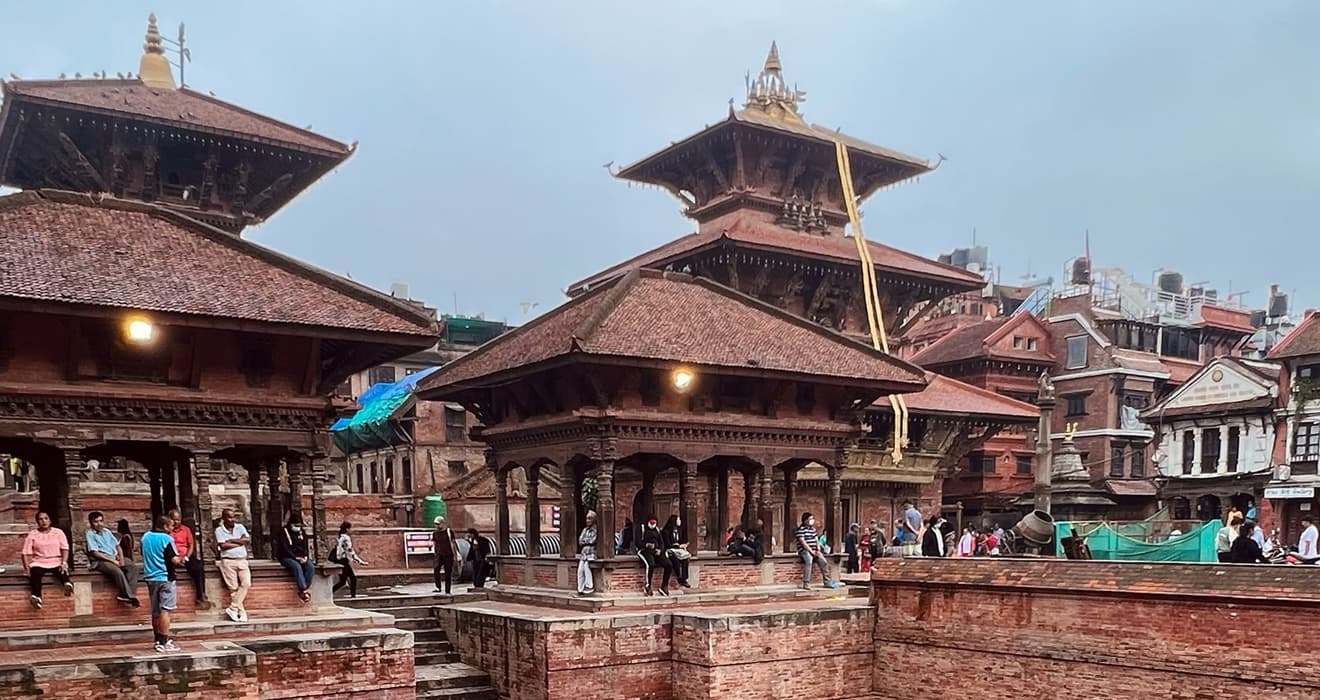
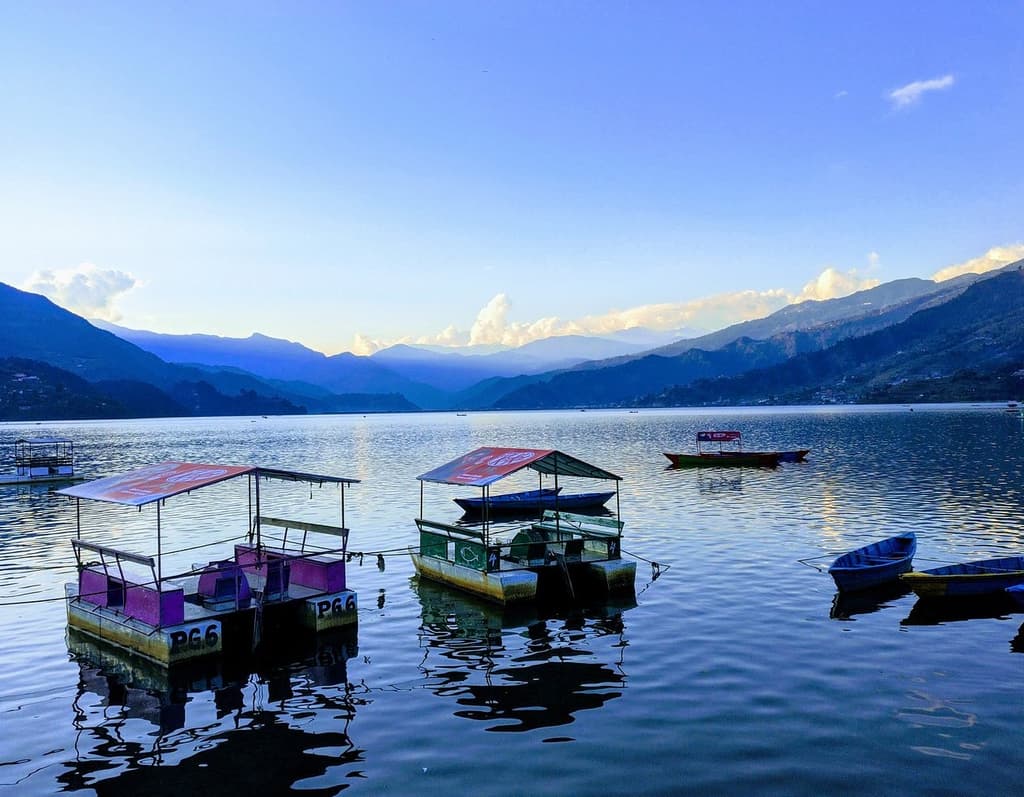
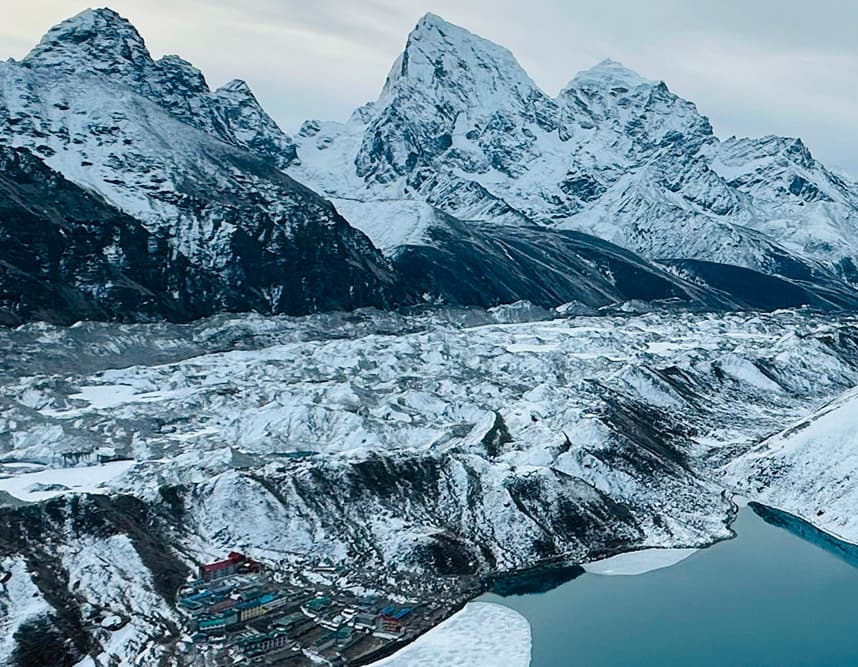
Post a Comment